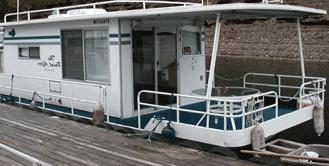
Older Houseboats with Steel Hulls - Repair and Replacement Costs?
by Spike
(Maryville, TN)
We have a question about older steel hull houseboats, when it comes to checking, maintenance, repairing, and or replacement costs?
How do you know when the Hull needs painting, or even checking for rust or corrosion? What clues will tell me if I need to get these things done.
We just bought a 1975 SumerSet Houseboat with a Steel Hull. The house boat was all redone inside, but the previous owner said it's been about 10 years since they had steel hull checked.
Thanks for any info, Spike.
 increase sales and profits with targeted traffic? Act now to get our 1/2 price sale, limited offer |
Reply - Answer
Well Spike, congratulations on your purchase of a 1975 Sumerset Houseboat, they are a great model, with many of them around. If I'm not mistaken, it was around 1975 that Sumerset started to offer customers an aluminum hull version, alongside of their steel hull versions.
Your question is a common one, since all hull materials require different levels of maintenance. When we look at steel, a natural process is the rust, thinness, and pinholes that can occur. Rust & Red Oxide occurs when air and water comes into contact with iron.
In retrospect, years ago, basically all houseboats were made or constructed with steel hulls, and then came about the aluminum and fiberglass models.
Let's look at Proper vs Poor Maintenance, and Average Costs:
=Poor Maintenance
General consensus is that a "poorly maintained" steel hull houseboat is at the "end of it's life" and will cost money to have it disposed of. Eventually costing more to repair and replaced all the rusted steel that it becomes a total loss.
=Proper Maintenance
A yearly maintenance program on a steel hull houseboat is almost an necessity, since this is what will keep the steel from rusting in the first place. You want to keep an eye on the bilge and all the hull interior areas since this is likely where most of it starts. You would to clean or sandblast the areas, and paint with epoxy paint.
=Average Costs
You didn't mention what size of houseboat you purchased, so these will be "ball-park figures".
If the houseboats needs to be hauled out, and launched, you could be looking at anywhere between @ $300 to 1,000 dollars.
If the houseboat needs to stay out on blocks for an extended period of time, you can calculate anywhere from @ 10 - 30 dollars per day for yard storage.
Since I personally am not in the steel hull repair business, I cannot quote precise numbers, but for a complete steel hull plate replacement, you could be
Now if you're only looking to have certain areas re-plated or repaired, you're looking at the cost of a welder, steel plates, and anti-fouling or coal tar epoxy.
Some Points to Consider about "steel hull houseboats" are:
1) Many insurance companies are making it very difficult to insure older steel hulled houseboats, and requiring very detailed marine surveys. They are worried about insuring "high risk, and high liability houseboats". Should you have any problems with insurance, have a look at our houseboat insurance page for tips and potential houseboat insurance companies.
2) One of the big advantages of steel houseboats, they take an impact very well, and can be easily repaired, and if the hull thickness becomes thin, new steel plates can be welded in place to completely repair the situation.
3) You can protect the hull (below the waterline) with either "anti-fouling paint", or "coal tar epoxy". Both are a preventative measure and worth the expense since the houseboat is already out of the water. Both can last years if the surface is properly prepared and applied.
4) As simple and easy way to verify and check the condition of the hull without having the expense of a "haul-out", you can consider to hire a diver to inspect it yearly. Many marinas have divers available to inspect, repair, and retrieve items. The prices are reasonable, and can range from @$100 to 300 dollars.
5) When it comes to the exterior maintenance, you can brush away any rust, and paint with with a metal paint of your choice. Some paints are better than others, but that's another big discussion. One of most important steps is once the area is ready for painting, I highly recommend applying a coat or two of Rust Metal Prep.

6) There are no "perfect houseboats", they all have pros & cons, so just take it all one step at a time, and eventually the list of things "To Do" are done. Enjoy your houseboat.
Lastly, hopefully some of our readers will share and post comments about their steel hull houseboat experiences.
Thanks for sharing, IAN from all-about-houseboats
Free Bonus Offer |
Comments for Older Houseboats with Steel Hulls - Repair and Replacement Costs?
|
||
|
||
|
||
|
||
|
||
|
||
|
||
|
||
|
||
|
||
|
||
|
||
|
||
|
||
|
||
|
||
|
||














